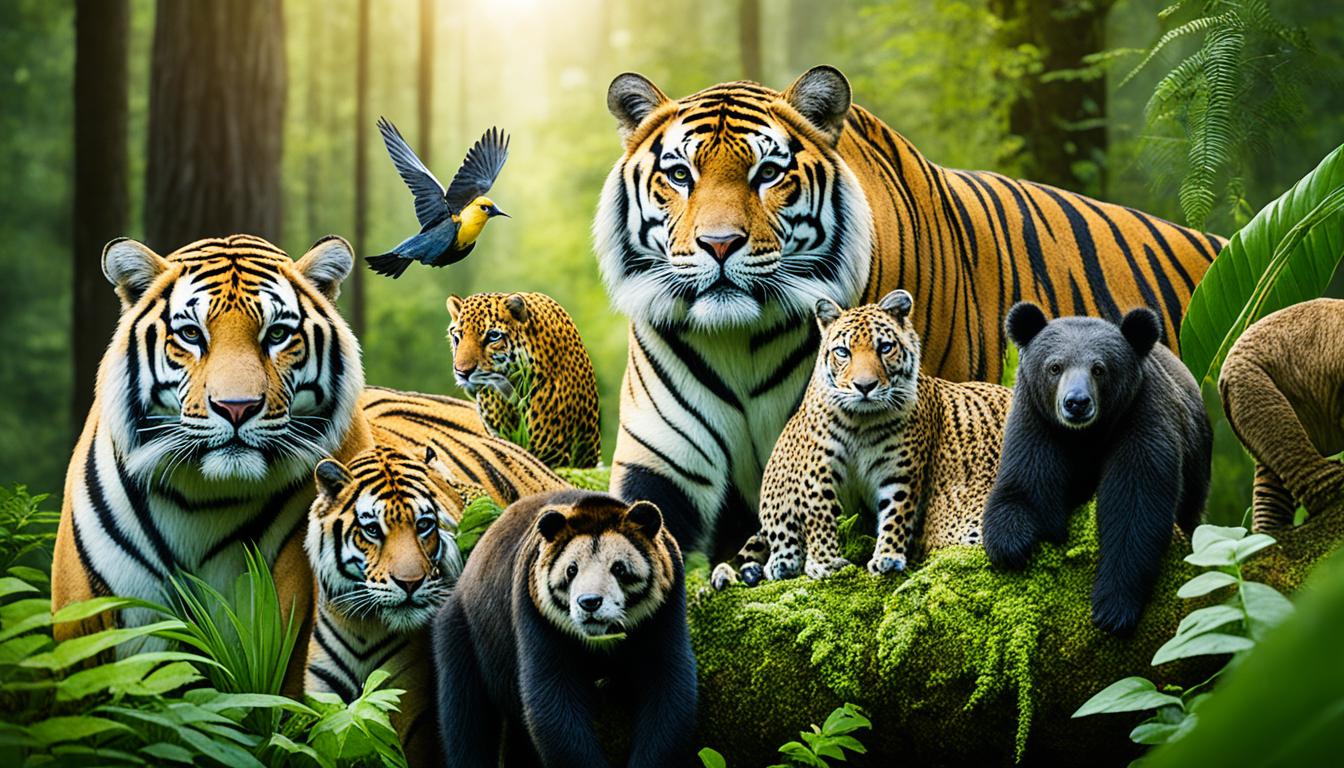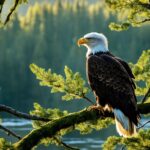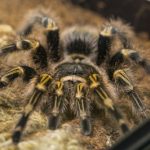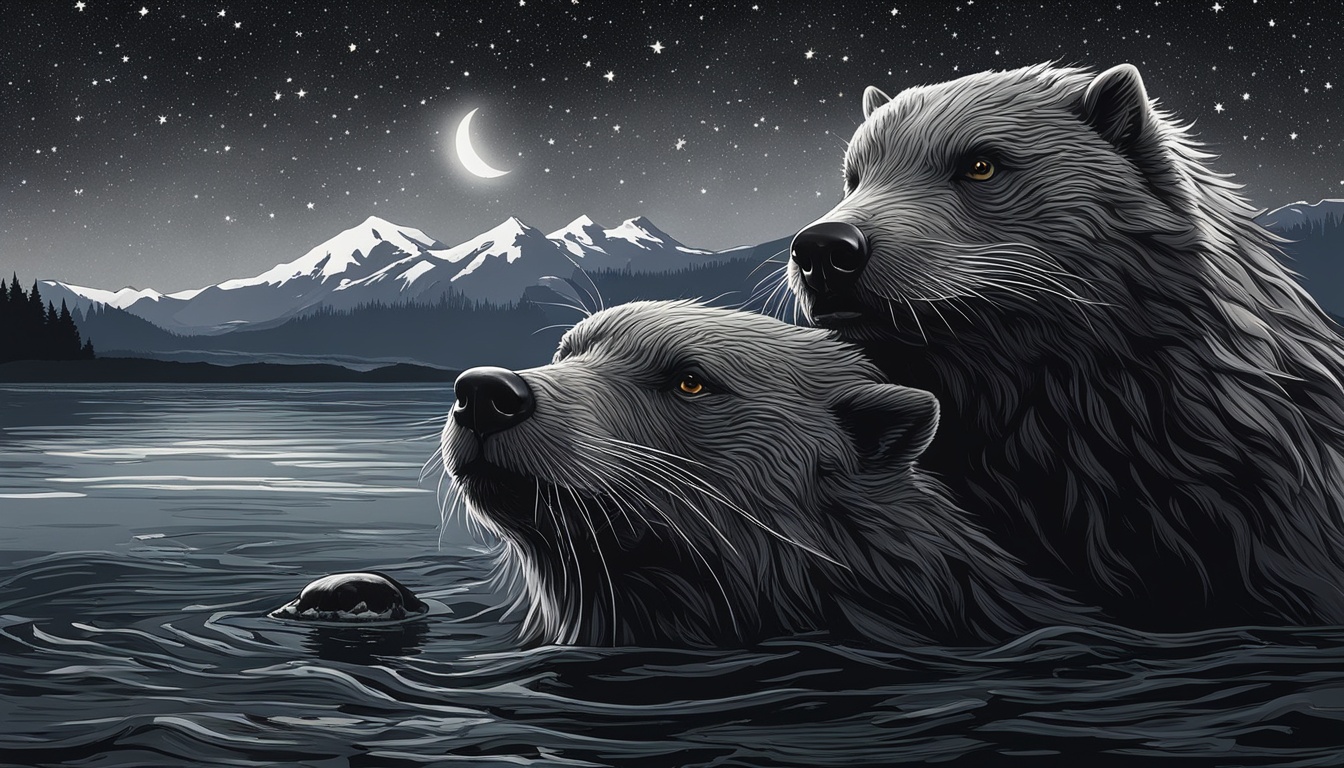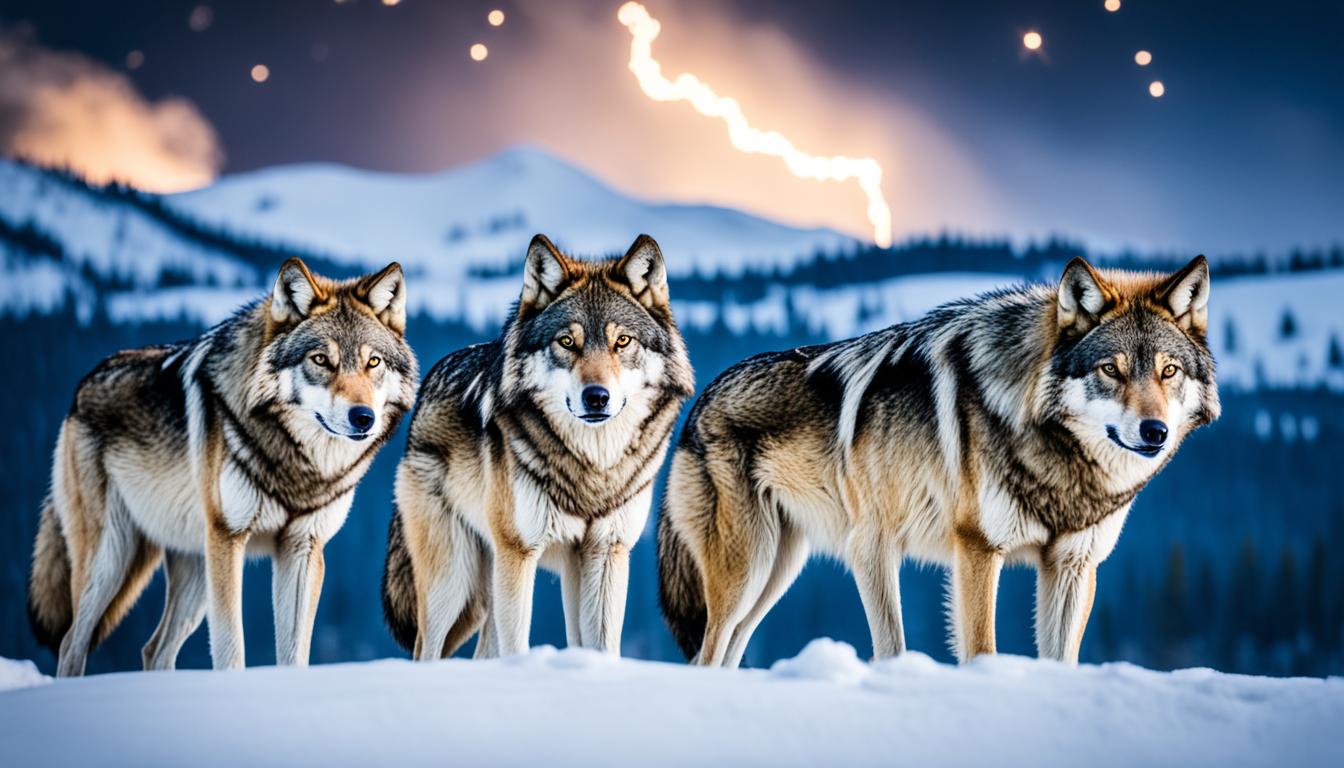Did you know that your choices at home can help save wildlife? It’s true! By using simple wildlife conservation tips, you can protect animals right in your backyard.
Planting native plants or helping broad wildlife initiatives is very important. Even helping at local zoos or avoiding harmful chemicals makes a big difference.
Also, joining projects as a citizen scientist or supporting trusted groups helps a lot. Keep reading to learn more about helping wildlife in the USA. Your actions can make our planet safer for animals.
Plant Native Species in Your Yard
Building a wildlife-friendly yard by using local plants brings many good things. It supports native animals and boosts biodiversity. This, in turn, makes your yard better for the planet.
Benefits of Native Plants
Native plants offer food and shelter to local wildlife. They are a good match for the weather and soil in your area. This means they use less water and care. Also, they help keep the air clean by making oxygen and taking in bad gases.
Steps to Create a Wildlife-Friendly Yard
To make your yard wildlife-friendly, start by choosing native plants. Get advice from gardening clubs or environmental groups. Think about birds, animals, and insects by planting a mix of trees, shrubs, and flowers. Leave some parts of your yard wild to support wildlife.
Reducing Lawn Areas for Wildlife
Making less lawn and more native gardens is good for nature. It saves water and gives wildlife a better home. Native plants are key to building spaces where animals can live and thrive.
Volunteer for Wildlife Conservation Organizations
Getting involved in conservation volunteering opportunities is a great way to help. You can work with local groups that love trees or support efforts at zoos and aquariums. Not only will you be helping animals, but you’ll learn a lot about saving the planet’s variety of life.
Many organizations welcome wildlife lovers. The Animal Welfare Institute is one of these places. They let you do critical advocacy work like writing to leaders and helping change policies for animals. This work is key in making a difference for wildlife in the long run.
If you like to help out from home, there are options for you, too. For example, you could take part in projects like checking on animals and teaching others online. This way, more people can join in wildlife habitat restoration projects no matter where they are. It’s all about making it easy for everyone to help out with saving animals and their homes.
Here’s a quick look at different ways you can volunteer:
| Type of Volunteering | Activities | Organizations |
|---|---|---|
| Local Community Support | Tree planting, clean-ups | TreePeople, Stayatirement |
| Zoo and Aquarium Assistance | Animal care, educational programs | San Diego Zoo, Monterey Bay Aquarium |
| Remote Volunteering | Animal monitoring, advocacy | AWI, Wildlife Conservation Society |
Support Zoos and Aquariums with Conservation Programs
Visiting zoos and aquariums is key to helping protect endangered species and more. They lead efforts in saving animals by offering chances to get involved. You can volunteer or learn, supporting saving wildlife and learning more about its threats.
Volunteer Opportunities at Zoos
At zoos, you can join in by helping as a volunteer. For example, you could become a docent. This role lets you talk to people about the need for wildlife protection and what’s being done to help. It’s a way to really make a difference and get others excited about protecting animals.
Supporting Aquariums’ Conservation Efforts
Aquariums are also vital in saving endangered animals. You can help by fundraising or spreading the word. These efforts are key in keeping up with the animals’ needs. They make sure that we have the resources to protect our oceans and the life within them. Joining in shows you care about saving animals both in the sea and on land.
Participate in Citizen Science Projects
Citizen science projects let people join real scientific studies about the earth. They help us understand our impact on the environment better. Even those without a science background can take part by collecting important data. This data shapes how we protect nature in the future.
A great project is the Great Sunflower Project. It asks people to watch pollinators like bees and record what they see. This helps us know how these important insects are doing. Also, Cornell University’s Lab of Ornithology has a program called Nestwatch. It lets people follow and tell about bird nesting. This joins in efforts to research and save bird species.
But citizen science doesn’t stop at local projects. Activities like counting iguanas in the Galapagos or noting sea life sightings need help from around the world. By taking part, you learn more about your impact on the planet. Plus, researchers get more data for protecting different species and managing wildlife.
Here are popular projects you can join:
- The Great Sunflower Project
- Cornell University Lab of Ornithology’s Nestwatch
- Galapagos Iguana Monitoring
- Marine Life Observation Initiatives
- Butterfly and Pollinator Counts
Joining in on these projects helps with science and strengthens a group of nature lovers. You play a part in safeguarding our planet, whether nearby or far away. Your help really does matter.
Make Your Yard a Wildlife Haven
Your yard can become a welcoming space for wildlife. Add bird feeders and houses to help birds. Plant flowers that attract bees and butterflies to support them.
Installing Bird Feeders and Houses
Bird feeders, baths, and houses are important. They give birds food and a place to live. The National Wildlife Federation offers tips for creating a bird-friendly space.
Providing Pollinator Habitats
Bees and butterflies are vital for a healthy ecosystem. Planting native flowers and shrubs helps them find food all year. This practice makes your yard more beautiful while helping the environment.
| Element | Benefit |
|---|---|
| Bird Feeders | Provide food and attract various bird species |
| Bird Houses | Offer shelter and nesting sites |
| Pollinator-Friendly Plants | Support bees, butterflies, and other pollinators |
| Water Features | Provide drinking and bathing water for birds |
By adding these features, you make your yard a haven for wildlife. It’s a way to enjoy nature while helping local animals thrive.
Advocate for Wildlife Protection Policies
Getting involved in wildlife protection initiatives is a strong way to support the protection of many animal species. When people join in, it helps show the need for laws to keep wildlife safe.
Groups like the Humane Society and World Wildlife Fund are great places to learn how to help. You might write to leaders, sign petitions, or spread the word to others.
The Humane Society says, “What you do on your own can really affect how laws to protect animals are made and used.”
Plus, getting those around you to also back wildlife protection initiatives strengthens the push for better laws. By working to advocate for wildlife policies, you’re part of a big team aiming for a bright future for many species.
Avoid Chemicals Harmful to Wildlife
Conventional lawn and garden products can hurt important insects like bees and butterflies. It’s key to find safer ways. These include natural methods that help the environment and protect wildlife.
Using Natural Pest Control
Natural ways to control pests work well and don’t harm the environment. For example, you can use good bugs to eat the bad ones, or neem oil. Diatomaceous earth is another safe choice.
Organic Fertilizer Alternatives
Fertilizers like compost, manure, and bone meal are good for the soil. They don’t use harsh chemicals. This helps plants grow strong, while keeping wildlife safe.
| Conventional Methods | Natural Alternatives |
|---|---|
| Chemical Pesticides | Predatory Insects, Neem Oil, Diatomaceous Earth |
| Synthetic Fertilizers | Compost, Manure, Bone Meal |
Reduce, Reuse, and Recycle
Reducing, reusing, and recycling helps protect nature and wildlife. It makes us more aware of our impact on the planet. These small habits can greatly help our environment.
- Reduce your use. Buy things with less packaging. Choose long-lasting stuff over throwaway items.
- Reuse things instead of tossing them. Use shopping bags and bottles that you can use again.
- Recycle the right way. Follow local rules to recycle well and save resources.
Less buying and reusing things not just reduces waste. It also saves energy and protects nature. By doing these, we support saving the homes of animals. Together, we can make our planet better for all creatures.
“The choices we make in our everyday lives can have a profound impact on the health of our planet. By practicing reduce, reuse, and recycle, we are taking crucial steps toward protecting wildlife and their habitats.”
Let’s see how reduce, reuse, and recycle help our world:
| Action | Benefits to Environment | Benefits to Wildlife Conservation |
|---|---|---|
| Reduce | Less waste and lower energy use | Fewer changes to animal homes and less pollution |
| Reuse | Things last longer and fewer new resources are needed | Less harm to places where animals live |
| Recycle | Save materials and reduce waste | Stop poisonous substances from hurting nature |
Living these habits helps us all. They make us more aware of our planet’s needs. By reducing, reusing, and recycling, you are helping save the earth and the animals that call it home.
Help with Endangered Species Preservation
Saving endangered species helps keep our planet’s balance healthy. To help, learn more and get involved in protecting wildlife.
Learn About Endangered Species
To save endangered animals, we must first know why they need our help. Get information from places like the U.S. Fish and Wildlife Service. Knowing what they need helps you give the right support.
Support Conservation Efforts for Endangered Animals
Helping in conservation projects is key to saving endangered animals. You can give money, speak for them, or work as a volunteer. Endangered species preservation needs your support and someone to speak out about it.
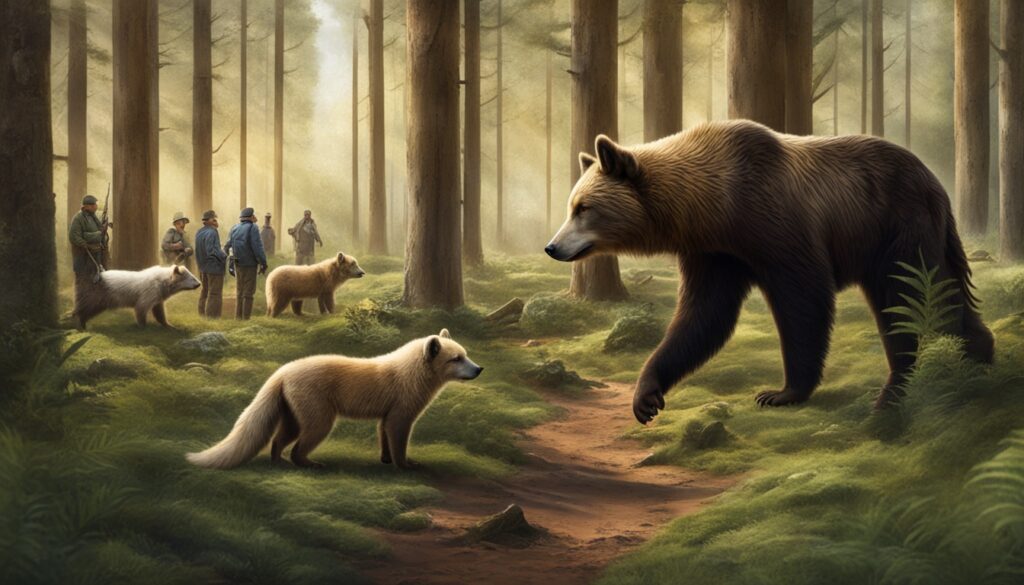
Here is a table to compare groups helping endangered animals and how you can help:
| Organization | Focus Area | Ways to Support |
|---|---|---|
| World Wildlife Fund (WWF) | Global wildlife conservation | Donations, Advocacy, Volunteering |
| U.S. Fish and Wildlife Service | Endangered species in the U.S. | Donations, Educational Resources |
| Wildlife Conservation Society | International wildlife protection initiatives | Fundraising, Supporting Field Projects |
Minimize Your Environmental Impact
It’s crucial to decrease your impact for wildlife and healthy nature. By being mindful in our daily actions, we can help wildlife and their homes. Here’s what you can do:
- Try to reduce and reuse to cut down on waste. This helps prevent litter that can hurt animals.
- At home, use appliances and lights that save energy. This way, you lower the harmful gases you emit.
- Get involved in projects that work on bringing back animal and plant homes. Look for local efforts in your area.
Also, cutting down on light that disturbs animals at night is important. By using softer lights and sensors, you can keep animals from getting confused.
Buying items that are made and used in a way that doesn’t harm the earth is a great step forward.
Keeping a safe distance from wild creatures matters a lot. It helps protect their peace and stops problems between people and animals.
Donate to Trusted Animal Conservation Organizations
Give to respected animal conservation groups to really make a difference. Your money will go towards key efforts like improving habitats and needed research. When you donate, you keep these important projects alive and growing.
Trusted names like the World Wildlife Fund (WWF) and the Wildlife Conservation Society (WCS) stand out. They are clear with their goals and use money wisely. Your support helps protect animals from poaching and regrow their lost homes. It’s these donations that keep the fight for wild animals going strong.
Your donations also help run places like animal sanctuaries and rescue centers. These places care for endangered and rescued animals. Your help ensures these animals get the care they need. So, by giving, you’re helping save many species and supporting those who do this tough but vital work.

